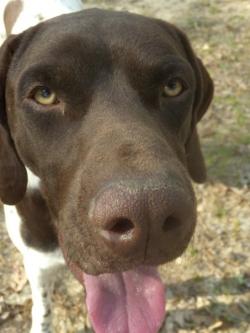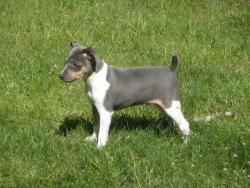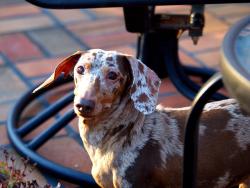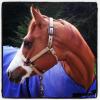Adding to the basics: Dilutions and Modifiers in Dogs
There are many different dilution and modifier genes that can affect coat color (and sometimes skin pigmentation) in dogs. These include Brown (liver), Dilution (the D locus), Dilution of Red (Pheomelanin), Urajiro, graying, and merle.

Sunset Acres 50 Cent is a wonderful example of a black and tan rat terrier whose black areas have been diluted to brown. Notice the intensity of the red (tan) pigment is not reduced. Photo courtesy of rodeoratdogs

Brooks is a German shorthair pointer showing off the diluted skin on his nose and light eyes. Photo courtesy of Krickette
Brown
Brown reduces the intensity of black pigment in the coat, skin, and eyes. Red pigment (pheomelanin) is not affected. It is found at the B locus (TYRP1). To date, there are three (3) known recessive alleles that can occur. These are bS, bd, and bc. If a dog is homozygous for any two of these alleles, the dog will be brown; i.e. bdbc will be brown as well as bdbd. In dogs that are ee, the red pigment in their coat will not be diluted, but the black pigment in their skin and pads will be diluted.
Technically, brown is not a dilution, but a modifier. It is a classified as a modifier because it does not affect density or distribution of pigment, but rather alters the shape of the pigment on the microscopic level. This change in shape reflects light differently, altering the visible color. For more about TYRP1 mutations Color Across Species Part 3: TYRP1. For more photo examples of brown dogs see theBrown Dogs Photo Gallery

Black and tan Rat Terrier diluted to blue and tan by dd. Photo courtesy of rodeoratdogs

A pair of black dilute (dd) Shar Pei. This photo was originally taken from Wikipedia as an Open Source Photo photo. However, it has since been removed. If you own this photo please contact me.
Dilution
Dilution can be a bit confusing because not only is it a dilution, its name is Dilution. This does not mean it is the only dilution that occurs in dogs. Dilution is found on the D locus (dilution series) and is recessive (a dog must be dd to express it). Dilution reduces the intensity of both black and red pigment, although black is affected more than red. Black pigment is diluted to a gray or "blue" color and red pigment is diluted to tan. There are known to be at least two variants of dilution. The mutation for only one has been located. The second mutation is found in Doberman Pinscher, French Bulldog, Italian Greyhound, Chow Chow and Shar-Pei and probably others as well. If a dog carries both a known and unknown dilution mutation it can still appear "diluted". For more information about Dilution Color Across Species part 2: MLPH For dilution images see Dilution Examples
Black and Silver Miniature Schnauzer. Open Source Photo
A Canadian White Shepherd showing off its very pale coat. Open Source Photo
Dilution of Red (Pheomelanin)
The dilution of pheomelanin (red pigment) in the the coat can vary from rich cream to white. It can affect both black based dogs (EM,EG,or E) and recessive red dogs (ee). The eyes and skin will remain dark (unless affected by something else). In a recessive red, this dilution causes a cream/white coat color. In a black based dog, it will dilute any red portions of the coat. Again, this can range from cream to white. This dilution has been referred to as chinchilla in the past, and attributed to SLC45A2 (previously called MATP), or TYR genes. Recent studies of this color have shown that SLC45A2 or TYR are not responsible, at least in the breeds studied. It is theorized there may be several recessive dilution alleles, at this locus, that work to cause the various levels of red dilution seen. 1Dilution of Red Examples

Red based Shiba-Inu displaying Urajiro. Open Source Photo

A black and tan Shiba-Inu displaying Urajiro. Open Source Photo
Urajiro
Urajiro is a modifier that only affects the underside of the dog. It dilutes the pigment in these areas to a very light cream or white. Some breeds, like the Shibas Inu, are required to have urajiro in the following areas: 1. The mouth sides and cheeks 2. Each undersection of the jaw, neck, chest and stomach 3. The forechest, extending to the shoulder joint, but not extending onto the shoulder itself shibas.org. It appears to follow a recessive inheritance pattern.
A Kerry Blue Terrier expressing graying. Open Source Photo
Graying
Graying is a progressive characteristic, with the dog being born full color and then slowly "silvering" as the dog ages. Rather than causing white hairs to be mixed into the coat, as is seen in horses, graying in dogs causes each individual hair to lighten as it grows. This causes the hair tips to be lighter than the roots. This is also most likely the reason this gene is seen almost exclusively in long haired breeds. It may be present in short haired breeds, but goes unnoticed in the shorter coat. Graying is a dominant characteristic and only affects black pigment in the coat. This means that the eyes and skin are not affected. In dogs that have a face mask (EM), the mask is not affected by graying, as can be seen on the dog at right.

Brown (Liver) Merle Dachshund Open Source Photo
A black and tan Koolie expressing merle. Open Source Photo
Merle
Merle is a bit different from the dilutions and modifiers we have discussed so far. It only affects black pigment and it does so in patches. These diluted patches result in a mottled appearance. Merle is also an incomplete dominant, meaning that dogs that have two copies of the merle gene are more profoundly affected than dogs that carry only one copy. In dogs who carry only one copy of merle, one or both eyes can be blue, although they can be normally colored as well. In dogs that are homozygous for merle, the eyes are more likely to be blue, and the coat will have more white than a non-merle or single merle from similar lines. As with some white patterns, the expression of merle varies from dog to dog; with some heterozygous merles being completely normally colored, but still able to pass on merle to their offspring. Merle dogs can be afflicted with a myriad of health problems, with the worst cases being found in dogs who are homozygous. Most heterozygous merle dogs function normally, with minimal visual and auditory problems. But these problems can include: increased pressure in the inner eye, decreased ability of the eye to focus (near sighted), and reduced hearing, ranging from mild to severe. Being homozygous for merle greatly increases the chance of health problems. Systems that can be affected include the skeletal, cardiac, and reproductive systems, as well as vision and hearing. Homozygous merle dogs can be blind, deaf, or both. Because of the health problems that can result, breeding merle to merle is strongly discouraged. To view a photo of a double merle Great Dane with affected eyes click here. I didn't include the photo as some readers may find it disturbing.

Looks really great
Looks really great :)